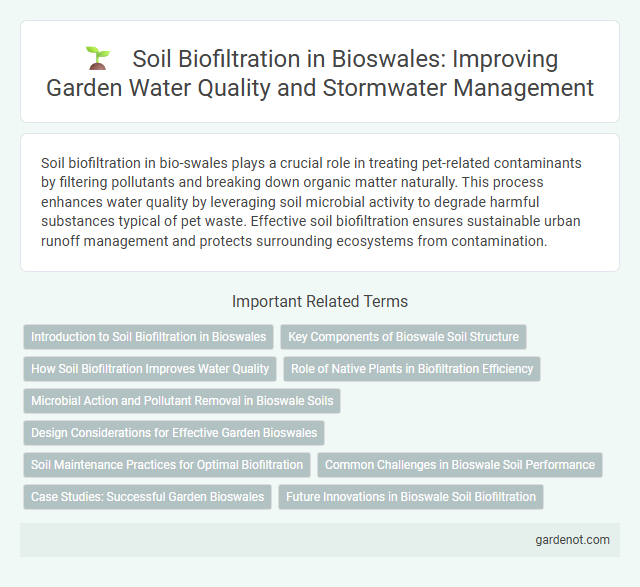Soil biofiltration in bio-swales plays a crucial role in treating pet-related contaminants by filtering pollutants and breaking down organic matter naturally. This process enhances water quality by leveraging soil microbial activity to degrade harmful substances typical of pet waste. Effective soil biofiltration ensures sustainable urban runoff management and protects surrounding ecosystems from contamination.
Introduction to Soil Biofiltration in Bioswales
Soil biofiltration in bioswales involves using engineered soil layers to capture, filter, and treat stormwater runoff by removing sediments, nutrients, and pollutants. This natural filtration process enhances groundwater recharge and improves water quality through microbial degradation and physical filtration mechanisms. Optimized soil composition with organic matter and proper permeability is crucial for effective pollutant removal and maintaining bioswale function.
Key Components of Bioswale Soil Structure
Bioswale soil structure relies on a layered composition of sandy loam, compost, and organic matter to enhance soil biofiltration, promoting effective filtration of stormwater pollutants. Key components include a permeable soil matrix that supports microbial activity, which is essential for decomposing contaminants and facilitating nutrient cycling. Adequate porosity and soil aggregation improve water infiltration rates and prevent clogging, ensuring long-term bioswale functionality.
How Soil Biofiltration Improves Water Quality
Soil biofiltration enhances water quality by utilizing natural soil layers to filter pollutants, including sediments, nutrients, and heavy metals, from stormwater runoff. Microbial activity within the biofiltration media breaks down organic contaminants, while soil particles trap suspended solids, reducing turbidity and improving clarity. This process significantly reduces nutrient loads such as nitrogen and phosphorus, preventing eutrophication and protecting aquatic ecosystems.
Role of Native Plants in Biofiltration Efficiency
Native plants enhance soil biofiltration by improving pollutant uptake and promoting microbial diversity in bio-swales. Their deep root systems increase soil permeability and support the breakdown of contaminants such as heavy metals and nutrients. Incorporating native species optimizes biofiltration efficiency by maintaining ecological balance and resilience in stormwater management systems.
Microbial Action and Pollutant Removal in Bioswale Soils
Microbial action in bioswale soils plays a critical role in breaking down organic pollutants and transforming nutrients through biofiltration processes. Diverse microbial communities enhance the degradation of contaminants such as hydrocarbons, heavy metals, and nitrogen compounds, improving water quality. Optimized soil conditions in bioswales promote microbial activity, increasing pollutant removal efficiency and supporting sustainable stormwater management.
Design Considerations for Effective Garden Bioswales
Garden bioswales require precise soil biofiltration properties to efficiently manage stormwater runoff and enhance pollutant removal. Incorporating well-draining, nutrient-rich soils combined with native vegetation optimizes infiltration rates and supports microbial activity crucial for biodegradation of contaminants. Proper layering with sand, compost, and topsoil ensures effective filtration while preventing soil compaction and maintaining long-term bioswale performance.
Soil Maintenance Practices for Optimal Biofiltration
Soil maintenance practices are crucial for enhancing biofiltration efficiency in bio-swales by preserving soil structure and promoting microbial activity. Regular mulching, aeration, and organic matter amendments improve soil porosity and nutrient cycling, facilitating pollutant degradation. Monitoring soil moisture levels and avoiding compaction sustain infiltration rates and optimize contaminant removal through natural filtration processes.
Common Challenges in Bioswale Soil Performance
Soil biofiltration in bioswales faces common challenges such as soil compaction, which reduces infiltration rates and limits pollutant removal efficiency. Nutrient imbalances and low microbial activity within the soil matrix hinder the biodegradation of contaminants. Maintaining optimal moisture levels is critical to prevent soil saturation and ensure effective pollutant retention and treatment.
Case Studies: Successful Garden Bioswales
Soil biofiltration in garden bioswales has proven effective in reducing urban stormwater pollutants and enhancing groundwater recharge. Case studies in cities like Portland and Seattle demonstrate over 70% removal rates of heavy metals and nutrients through layered soil media combined with native vegetation. These successful implementations highlight bioswales as sustainable green infrastructure for managing runoff and improving water quality.
Future Innovations in Bioswale Soil Biofiltration
Future innovations in bioswale soil biofiltration emphasize enhanced microbial consortia engineered to degrade emerging contaminants more efficiently, improving pollutant removal rates. Advanced soil amendments incorporating nanomaterials and biochar increase adsorption capacity and nutrient retention, promoting healthier vegetation and longer-lasting filtration performance. Integration of sensor technology enables real-time monitoring of soil moisture and contaminant levels, optimizing maintenance schedules and maximizing bioswale effectiveness in urban stormwater management systems.
Soil biofiltration Infographic

 gardenot.com
gardenot.com